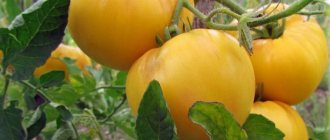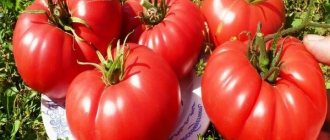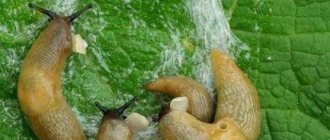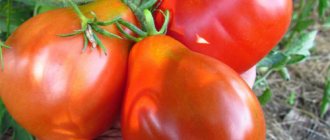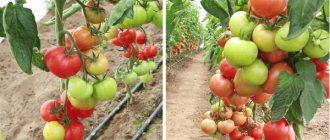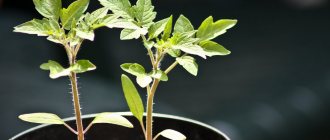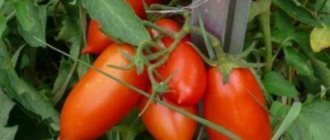Characteristics and description of the variety
Increased attention and love for Handsome is due to its excellent taste, high productivity and ease of care. The variety belongs to tall tomatoes, but this mostly depends on weather conditions. In a favorable warm climate, the bush can grow up to 4 meters, but in the northern regions the maximum height of Handsome will not exceed 2–2.5 meters.
The inflorescence is simple - each branch usually produces from 9 to 13 fruits. The variety is distinguished by a fairly developed root system, strong stem and very spreading branches that need to be tied up.
Recognizing tomatoes of the Krasavchik variety is not difficult - they can be easily identified by appearance and taste. The fruits are cylindrical in shape, bright red in color, their average weight varies from 60 to 110 g. Their distinctive feature is their long shelf life - from 2 to 3 weeks after collection. In terms of its taste, the variety is not inferior to new-fangled hybrids - the fruits are very sweet, with fleshy pulp and a dense skin, which allows the tomatoes to withstand transportation well.
In addition, Handsome also boasts a minimal number of seeds and three chambers inside each fruit, and these are not all the advantages of the variety. Its productivity level is very high - provided all agrotechnical practices are followed, up to 8 kg of tomatoes can be harvested from one bush. A significant role in this is played by the variety’s resistance to adverse weather conditions, diseases and pests.
Did you know?
Regular consumption of tomatoes and their processed products can significantly reduce the risk of cancer.
Varieties for open ground
A huge number of species with excellent yields are intended for growing vegetables in the open air. Low-growing bushes with large fruits are one of the advantages of tomatoes for the soil. Such heat-loving plants are easier to care for and do not require complex agricultural practices.
According to ripening period
Tomatoes, like other vegetable crops, are characterized by different ripening periods, from early to late.
The ripening time, color and shape of tomatoes depends on the variety.
Usually early-ripening vegetables with not large fruits and not a large harvest, but with a quick, friendly yield of ripe tomatoes. Mid-season ones also have medium sizes. Late ones are usually difficult to care for, but it is among them that you can find champions in weight, but there are not many such beauties on the bush.
By growing region
Every year, breeders create new species with high quality indicators. In stores you can buy specialized varieties of tomatoes designed for growing in certain climatic conditions. Classification by regions of Russia:
- for the Moscow region: Champion, Sweet Bunch, Honey, Pink Elephant, Fireworks, Bull's forehead;
- for the southern regions: Torch, Novice, Titan, Winner, Bison, Ermak, Gift, Mikado;
- for the middle zone: Bull's Heart, Black Prince, Uzbek (Yusupov), Moskvichka, Snowdrop, Big Brother, Spasskaya Tower;
- for Siberia: Siberian heavyweight, Ultra early ripening, Sanka, Abakan pink;
- for the Urals: Coin, Bull's Heart, Button, Countryman, Yellow Buyan, Bullfinch, Demidov;
- for the far north: Snowy Tale, Ballerina, Ladyfingers, Berdsky Large, Countryman, Oak, Gina.
An unpredictable, cold or, conversely, excessively warm climate is not a reason to refuse to grow tomatoes in open ground. Thanks to selection, varieties have been developed that grow and develop well in any terrain.
According to disease resistance
To obtain a rich harvest, you need to choose tomato varieties not only with the appropriate characteristics. It is necessary that this criterion be supplemented by such an indicator as disease resistance.
Pros and cons of the variety
The fruits of the variety in question, like any other, have their strengths and weaknesses.
Among the many advantages of Handsome, the following can be highlighted:
- high productivity;
- unpretentiousness in cultivation;
- good resistance to sudden weather changes, diseases and pests;
- high transportability;
- presentable presentation;
- excellent taste;
- versatility in application;
- long shelf life.
Among the disadvantages, gardeners highlight the difficulties that arise when independently propagating seeds - in the second year of planting, hybrid forms of the variety rarely produce a harvest. At the same time, Handsome definitely needs the formation of a bush, otherwise the stem will grow throughout the entire growing season, which will cause many difficulties in the future.
Basic growing rules
Cultivation of Krasavchik tomatoes is possible both in open ground and in greenhouse conditions - the yield will be equally high in both the first and second cases. The variety is quite unpretentious, and therefore the growing process will not cause difficulties - you just need to promptly carry out standard agrotechnical procedures for caring for the plant.
Important!
The worst predecessor of tomatoes is potatoes
-
refrain from growing the crop in the same place where another representative of the nightshade family grows.
Growing seedlings
It is advisable to plant seedlings 1.5–2 months before planting in a permanent place - that is, in late February - early March. Before this, the seeds must be subjected to disinfection in order to eliminate possible pathogens of various diseases. To do this, you can use a 1% solution of potassium permanganate (1.5 g per 100 ml of water): the seed is wrapped in gauze for 15–20 minutes, after which it is washed with water. In addition to disinfection, this procedure also helps speed up germination.
Soil for tomato seedlings can be either purchased or taken from the garden - the main thing is that the soil is light and loose. A good option would be to use peat tablets - in addition to saving space, the seeds in them will feel quite comfortable and develop well. The most suitable container for seedlings of tomatoes of the described variety are seedling boxes - the seeds are planted in shallow holes, lightly sprinkled with soil and covered with a film or lid on top.
Further care of seedlings includes creating a suitable temperature regime, lighting and timely watering. Since tomatoes are extremely demanding on lighting, the optimal amount of time spent by seedlings in the light should be at least 16 hours a day.
To prevent the sprouts from stretching, the temperature regime must be moderate - during the daytime, the crops should be at a temperature of +17 to +23°C, and at night this figure must be reduced to +13...+15°C. As for watering, it is very important not to overdo it and not to overwater the seedlings, otherwise the crops will quickly rot. The procedure should be started only after the first leaf appears on the sprouts - in the future, the frequency of watering is reduced to once a week.
Preparing the soil for planting seedlings
Preparing the soil for seedlings should begin in the fall so that its upper layers are thoroughly frozen in winter. Typically, preparatory procedures include thoroughly clearing the bed of debris and plant debris, digging up the soil and applying fertilizer.
Already in mid-September, it is necessary to completely remove weeds and fallen leaves - plant debris not only pollutes the area, but also serves as a breeding ground for the development of dangerous microbes and bacteria. Next, the soil should be dug to a depth of about 25 cm - this way the soil will be fully saturated with the required amount of moisture and air.
The final stage in preparing the soil is its saturation with nutrients, and here you should act very carefully, since excess fertilizer can seriously harm the tomatoes, and instead of the expected increased fruit set, the plants will begin to actively grow green mass. The most suitable soil mixture for tomatoes is the following composition: 50% peat, 30% sand and 20% compost. Based on this, both organic components - manure or humus, and microelements can be used as fertilizers.
Tomatoes especially need potassium and nitrogen (45–50 g per 1 m²). It is recommended to apply fertilizers not after, but during digging, so that all layers of soil are equally saturated with useful substances. After all the necessary procedures have been carried out efficiently, you can safely begin planting seedlings.
Technology of planting seedlings
Transplantation is always stressful for plants, so it is recommended to harden the seedlings a few weeks before the planned procedure. To do this, at first, briefly ventilate the room in which the crops are located, after which they take the seedlings out into the open air.
This event is best carried out on a cloudy day, but in case of sunny weather you should wait until the evening so that the plants have time to get stronger and tolerate the scorching sun well. The timing of planting seedlings depends mostly on the region - in the middle zone it is usually the beginning or middle of June. It is important that by this time a stable air temperature has been established - no less than +13°C, without the risk of possible cold snap.
General recommendations for planting tomato seedlings are as follows:
- Immediately before the transplantation procedure, the seedlings should be well watered - this will significantly reduce the likelihood of damage to the roots during the transplantation process, and removing plants from the container will cause much less difficulty.
- The next step is digging holes, and their depth should be 8–9 cm greater than the containers in which the plants were previously located. The finished wells are filled with water and left for a while.
- After the water in the holes is completely absorbed, the seedlings are carefully removed from the previous containers and deepened into the ground. The optimal distance between bushes should be at least 60 cm - then the plants will develop well without interfering with each other.
- After the manipulations with the plants have been completed, the holes are lightly sprinkled with earth, tamped down and filled with water (1–1.5 liters for each tomato).
- Immediately after transplanting the seedlings, the bed must be covered with film to protect the plants from unexpected night cold. After some time, after the seedlings have taken root, the film can be removed.
- At first, while the process of plant adaptation occurs, watering them is prohibited. Usually for tomatoes it takes about 8–10 days, after which the first watering procedure can be performed.
Did you know?
In the wild, tomatoes usually weigh no more than 1 gram, but the fruits of cultivated varieties can reach 1 kilogram or more.
Tomato handsome f1 reviews
The Krasavchik tomato belongs to a medium-ripening variety. It is valued among vegetable growers and gardeners primarily for its high level of productivity and low maintenance requirements.
Characteristics of the variety
It belongs to the indeterminate type, which means that the bushes can reach very high heights. In favorable warm conditions, the branch can reach 4 meters in height. In Russian climatic conditions, the maximum height of branches is up to 2 meters. In this regard, the plant needs to systematically trim the top.
“Handsome” tomatoes have a simple inflorescence. Each branch produces 8 to 12 fruits. They reach full maturity 105–115 days after the appearance of the first shoots.
The indeterminate type of plants has its advantages and disadvantages. Among the advantages:
- Possibility of obtaining a bountiful harvest from a minimal plot of land.
- High resistance to diseases and pests.
- Long-term fruiting - in the southern climate, you can collect fruits even at the beginning of autumn - throughout September.
- Convenience of the fruit harvesting process - due to the high growth of the bushes, the harvest is harvested while standing.
Flaws:
- Supports for each plant are required.
- The variety optimally reveals its advantages in the southern climate.
- It is necessary to promptly and carefully cut off all unnecessary branches and shoots (stepchildren), maintaining the formation of one trunk.
Description of the fruits of the Krasavchik variety
Tomatoes of this variety are easily recognized by their appearance and taste. The fruits are formed in the shape of a cylinder: elongated, oblong. They have a bright red color. Tomatoes are medium in size and may vary significantly in size. The fruits can weigh from 50 to 90 grams. There are two to three chambers inside the fetus.
The fruits are sweet, dense in consistency. Outwardly they resemble a bunch of grapes, as one branch can hold up to 12 fruits! Tomatoes tolerate transportation well. But they last from two to three weeks.
tomato Beauty F1 - description and characteristics of the variety
Growing and care
- This variety feels good both in open ground and under film. The culture does not require any special manipulations during the care process. Seedlings are usually planted, depending on climatic conditions, 1.5 - 2 months before planting at a permanent growing site.
- It is strongly recommended to harden the seedlings. This is necessary to reduce the level and effect of stress on the plant. This procedure is carried out 7-14 days before planting in open ground.
- As noted above, the “Krasavchik” variety belongs to the indeterminate type, and therefore requires pruning.
- Every bush needs support.
- The plant likes to be watered with warm water. It is preferable to water after sunset. It is also mandatory to loosen and weed the soil. The soil must have good air permeability so that the plant's root system can receive sufficient oxygen.
- To increase the amount of harvest, it is necessary to apply fertilizers at least two to three times per season.
- When planting tomatoes, it is necessary to maintain a distance between the bushes: 50-60 cm. This is quite enough so that the bushes can develop freely without interfering with each other.
The variety is very resistant to diseases typical of tomatoes. Among them: mosaic, fusarium, cladosporiosis (“brown spot”) and others.
tomato Red Coal - description and characteristics of the variety
Harvest and its use
This variety has a very high yield level. With proper care and fulfillment of all growing requirements, it is possible to get up to 7 kg of ripe, tasty fruits from 1 bush. This is partly due to the good resistance of the variety to weather changes and unfavorable climatic conditions.
The fruits are consumed fresh as a simple cut and added to salads. At the same time, you need to remember that tomatoes can be stored for a maximum of 21 days. In this regard, they are used for various preparations: pickles, canning, tomato sauce, pasta, and so on. At the same time, the tomatoes hold their shape well, which gives the preparations an attractive appearance.
The taste is equally good in any form of serving tomatoes: both in fresh salads and in winter preparations.
Handsome tomatoes are the right choice for growing, both in a greenhouse and in an open garden. Many vegetable growers have already appreciated this variety. Tomatoes are easy to care for and produce an excellent harvest. The fruits are consumed fresh and as part of snacks and preparations.
Red buffalo tomato - description and characteristics of the variety
Features of caring for the variety
The unpretentiousness of this handsome tomato allows you to achieve a good, tasty harvest without much expense - it is only important to correctly follow all the necessary agrotechnical procedures.
Fertilizers and watering
According to gardeners, Handsome is for the most part indifferent to fertilizing, but to increase the level of productivity this is a mandatory procedure.
Experienced gardeners recommend feeding the variety no more than 3 times per season - for this it is better to draw up a schedule for these activities in advance:
- The first time
feeding should be done 20 days after transplanting the seedlings into the ground, that is, during the period of the beginning of flowering. During the first procedure, it is important not to load the plants with nitrogen fertilizers, which will cause active growth of green mass and slow down the onset of fruiting, so it is better to limit yourself to a weak dressing - an infusion of bird droppings or mullein. For greater efficiency, you can also add a glass of ash to it - this will perfectly stimulate the budding of young plants and nourish them with all the necessary substances. - The next feeding
is done a week after the formation of the first ovaries. To do this, you can use this simple recipe - add 1 tablespoon of any mineral fertilizer (preparations such as Kemira and Mortar) and 4 grams of potassium permanganate to a ready-made solution of bird droppings (10 l). Since Krasavchik is a tall variety, the solution consumption should be at least 2 liters per bush. - The third and final
feeding procedure should take place during the collection of the first fruits. It can be done with the same solution as the second fertilizing, or you can give preference to potassium fertilizers - ash or potassium sulfate. To do this, you need to add 1 tablespoon of ash to a bucket of water and spend at the rate of 2.5 liters per bush. The falling of flowers and ovaries indicates a lack of boron in plants. The problem can be easily solved by spraying the flowers and leaves with a solution of boric acid (1 g per 1 liter of water).
As for watering, it is important not to over-moisten the soil, but also not to let it dry out. Tomatoes of the Handsome variety need abundant watering 1-2 times a week with exclusively warm water. It is important to carry out this procedure in the evening, that is, after sunset, spending at least 1 bucket of water for each bush. After waiting until it is absorbed, it is advisable to loosen the soil shallowly, being careful not to damage the roots.
Stepping and bush formation
One of the main features of the variety is the need to form a bush into one stem. This activity should begin at the very beginning of the growing season, that is, several weeks after planting the seedlings, since from an early age the plants begin to form side shoots.
Forming a bush is one of the most important procedures for obtaining a harvest as quickly as possible: thanks to it, plants begin to bear fruit in a timely and high-quality manner, without concentrating on the formation of excess green mass.
For indeterminate varieties, which include Krasavchik, one stem with 7-8 flower clusters is allowed. The stepson that is left under the first flower cluster will develop most quickly. In tall tomatoes it should be quite high - approximately above the 11-13 leaf.
The timely removal of the lower leaves also plays an important role - up to a distance of 35–40 between them and the ground. This is necessary primarily in order to protect plants from various sources of diseases and ensure air flow. The next step after forming 7-8 clusters is to pinch the tops in order to limit the growth of the stems. The frequency of this procedure depends on the activity of the plants - for tomatoes of the Krasavchik variety it is recommended to carry out pinching at least 2 times a week.
Important!
When removing side shoots, branches must be tied to a support.
Loosening the soil and weeding
Loosening and weeding of the soil are no less mandatory agricultural techniques for increasing the yield. It is very important that the soil under the plants is always loose - for this purpose the procedure is carried out after each watering, periodically combining it with weeding. The depth of loosening of tomatoes depends on their growing season - in the first few weeks after planting, the permissible norm is 11–13 cm, after which this figure decreases to 7–9 cm, so as not to harm the root system. In the case of heavy soil, it is necessary to loosen deeper, but only in those places where the roots have not yet penetrated.
After some time, it is necessary to add weeding to loosening: the procedure will avoid exposing the roots and will significantly speed up the onset of fruiting, since the presence of weeds has an extremely negative effect on the growth and quality of the crop. It is recommended to remove weeds manually, since mechanical devices can damage overgrown tomato roots.
Diseases and pests
Gardeners who have been growing the described variety in their beds for a long time note the amazing resistance of Handsome to various ailments, in particular to fusarium, mosaic and cladosporiosis. However, plant resistance does not exempt from preventive measures that can prevent infection.
In open ground conditions, tomatoes are much more susceptible to diseases, since most of them spread in conditions of high humidity. blight is one of the most dangerous nightshade diseases.
— brown spots on all ground organs of the plant, including fruits, will tell you about its appearance.
with gray or root rot cannot be ruled out.
- small round spots appear on the plants, gradually becoming covered with mold.
Another physiological disease that occurs as a result of waterlogging of the soil is cracking of tomatoes
. Abundant, frequent watering can cause rupture of the skin of the fruit, as a result of which they lose their presentation and attractiveness.
As for pests, during the process of growing crops you most often encounter the following harmful insects:
- Spider mite
. It is characterized by damage to the leaf blade - first it sucks all the juice out of it, after which it entwines it with a thin white web. The main reason for the appearance of this pest is dry air, so spider mites pose the greatest danger to plants that are poorly watered or ventilated. - Whitefly
- destroys crops mainly at the larval stage. Attaching to the leaves, they suck out all the juices from them, and a black fungal coating appears on the plants themselves, causing the rapid death of the fruits. - Wireworms
harm not so much the ground organs of plants as their roots. Making their way into the very depths of the soil, they actively devour the roots and then the stems of tomatoes.
Only due compliance with all agrotechnical precautions will help to avoid the above misfortunes, namely:
- use of healthy planting material;
- planting plants at the optimal distance from each other;
- immediate removal of infected specimens;
- deep digging of soil;
- correct and timely watering of plants;
- regular removal of plant residues and weeds from the site;
- compliance with crop rotation;
- correct application of microelements;
- treatment of plants with broad-spectrum fungicides, such as Fundazol, Fitosporin-M, Quadris and Funazim.
Rules for harvesting and storing crops
You can start harvesting tomatoes of the Krasavchik variety in late July - early August. If, after completing this procedure, you want to send the fruits for long-term storage, then collection should be carried out exclusively in dry weather and best in the morning. Large, healthy, not overripe fruits without visible skin defects should be selected.
Containers for storing tomatoes can be very different - from cardboard boxes to plastic boxes, the bottom of which is covered with paper. The lid of boxes and boxes should be selected so that when closing it does not put pressure on the tomatoes. It is best to cover plastic containers on top with burlap or other fairly dense material. This is due to the need to preserve ethylene, which has a positive effect on tomatoes.
The place where fruits are stored is no less important - it is not recommended to use a cellar for this purpose, since in conditions of high humidity they will quickly rot. In winter, the air temperature in the room where the crop is stored must be monitored especially carefully, otherwise the fruit will freeze. If the tomatoes have been selected for long-term storage, do not forget to regularly inspect them for the presence of rotten and diseased specimens, because by taking timely measures, you can save the rest of the harvest.
From the very beginning of its appearance on the market, the Krasavchik tomato variety has proven itself to be one of the best for growing. The positive reputation and reviews of experienced gardeners leave no doubt about the excellent taste of the variety, its unpretentiousness and high yield, and therefore it is an excellent choice for growing both in a greenhouse and in open ground.
https://fermer.blog/bok/ogorod/tomaty/sorta-tomatov/indeterminantnye-tomaty/4378-tomat-krasavchik-f1.html
Description of the handsome fleshy tomato, its advantages and disadvantages
The fleshy Beauty tomato not only produces a decent harvest, but is also a real decoration for the garden plot. The variety was bred in Russia and received certification more than 10 years ago.
Due to its unique characteristics, it is very popular among summer residents, owners of agricultural complexes and small farmers. Plants are grown in greenhouses and greenhouses; they also take root well in open beds.
Let's consider the characteristics of the variety, its advantages and disadvantages, rules of cultivation and care.
Basic properties of tomatoes
Reviews from gardeners, the characteristics they give and the description of the variety allow us to form a positive opinion about the Fleshy Handsome tomatoes. As for the height of the bush, it grows up to 200 cm, exceeding such domestic crops as Sedek, Empress and Krivyansky.
The stem is thick, dense and knotty. It accumulates enough moisture so that the plant can survive several hot days without watering. It is precisely because of the height of the bush that it is preferable to grow the variety in shelters to prevent it from being knocked over by the wind. The leaves are medium sized, dense, bright green.
The productivity of the variety is high. On open ground it is up to 12 kg per square meter. As for greenhouse conditions, there this figure reaches 15 kg.
The fruits are large and juicy, the average weight of one tomato is 250 g. The tomatoes have a regular round shape, the color is pink, sometimes light red. The skin is thin with a glossy sheen.
The pulp is fleshy, without fibers, with a pleasant tomato taste.
Analysis of reviews from consumers and gardeners made it possible to clearly formulate a list of strengths and weaknesses of the Fleshy Beauty variety.
Its advantages include:
- sizes of tomatoes, equally well suited for pickling in jars, slicing and salads;
- high resistance to infectious and fungal diseases;
- obtaining a bountiful harvest in late spring or early summer;
- unpretentiousness of the plant, it easily tolerates high and low temperatures;
- high yield, which is not much lower than that of the most famous varieties in the world;
- good shelf life, allowing you to preserve the fruits until the end of winter and even until the beginning of spring;
- resistance to most diseases that affect all varieties of tomatoes;
- the beauty and attractiveness of fully grown bushes with ripe tomatoes;
- ease of harvesting, since you do not have to bend over to find and pick the fruits.
As for the shortcomings, there are few of them. The bushes are powerful, tall and heavy. To prevent them from falling under the weight of the fruit or gusts of wind, a reliable and stable garter is required.
It is noted that at the seedling stage, the plant requires careful adherence to the watering and lighting regime.
In addition, the large size of the bush requires frequent application of organic and mineral fertilizers.
Features of cultivation
If you grow Krasavets fleshy in open ground, it is better to do this in the southern regions with stable warm weather and the absence of strong winds. In the middle zone, the variety needs to be cultivated in a greenhouse. In cool climates, insulated heated structures are necessary.
Seeds should be prepared before planting in containers. It is recommended to treat them with disinfectants and harden them for a week. After the first shoots appear, you need to provide them with constant lighting and a stable temperature.
Before planting, it is necessary to prepare the soil. A fertile mixture, charcoal and coarse fire-heated sand are added to the hole. A solution of copper sulfate or potassium permanganate is poured in a circle around each hole. This technique will protect the plant from insects and small rodents.
Fertilizing must be done at least 2 times a month. The plant loves solutions based on rotted manure and responds well to fertilizers that include ammonium nitrate. It is even better to use combination mixtures, which are sold ready-made at agricultural markets. With proper care, the Fleshy Handsome variety will please farmers with an excellent harvest.
Description and yield indicators
Tomato Krasavchik f1 was included in the register of breeding achievements in 2008. The hybrid does not require special attention to care, but produces a bountiful harvest. It differs in the average period of fruit ripening. Recommended for cultivation in personal gardens under film covers.
The plant has the following characteristics:
- The bush is tall, continues to lengthen after the formation of inflorescences, reaching 1.5–2 m in height.
- The fruits are collected on the branches in clusters of 8–12 pieces.
- Tomatoes ripen 100–115 days after planting the seeds.
- It has dense and strong stems.
- The shoots and foliage are pubescent on the front side and are colored rich green.
- The branches are spreading, for this reason the plants need supports and obligatory garter.
- Red fruits of round or cylindrical shape weigh 50–100 g. They have dense and fleshy pulp with a small number of seeds.
- The skin is dense, without green spots on the stalk, and does not crack or deform during transportation.
Important!
Hybrid Handsome has high transportability. After harvesting, the fruits can be easily stored for 2-3 weeks.
The marketable yield indicated in the State Register is 13.6 kg per square meter. m.
Pros and cons of the variety
Like all garden crops, the Handsome hybrid has advantages and disadvantages. Reviews from gardeners who grew the hybrid Handsome show that the advantages of the tomato are still much greater than the disadvantages.
Positive traits:
- resistance to pests and diseases;
- high productivity;
- unpretentiousness;
- attractive presentation;
- tomatoes do not crack or have green spots;
- forms ovaries even in unfavorable climatic conditions;
- excellent taste of the fruit;
- tolerates transportation well.
Disadvantages of culture:
- requires gartering and bush formation;
- You cannot propagate by seeds yourself.
How to grow a crop
The hybrid is suitable for cultivation in open ground and greenhouses. Sowing of seedlings is carried out 1.5–2 months before planting in a permanent place. The timing depends on the growing region; on average, seeds are planted in late February or early March.
Seedling
For sowing, seedling cassettes or plastic cups are used; drainage holes must be made in them to prevent moisture stagnation.
Instructions for growing seedlings:
- Soak the seeds in a 1% solution of potassium permanganate for 30 minutes, then rinse them in running water.
- Disinfect the containers and fill them with universal substrate for seedlings or a mixture prepared from sand and peat in a 1:1 ratio.
- Moisten the soil and plant one seed in each cup, pressing them 1 cm into the soil.
- Cover the plantings with film or a piece of glass; this will help maintain the required humidity and temperature.
- After the first shoots appear, remove the greenhouse.
- Water with a spray bottle to avoid damaging the young shoots.
- After the formation of the first true leaves, begin hardening. To do this, reduce the room temperature to 10–15 °C during the day and 8–10 °C at night for three days. Repeat the procedure periodically; in total, the seedlings should spend at least 2 weeks in such conditions.
Transplantation into the ground plot
To grow tomatoes, choose a warm place, sheltered from the wind, with good lighting.
Handsome's predecessors could be:
- cucumbers;
- onion;
- zucchini;
- cabbage.
But after peppers, eggplants and potatoes, it is better not to plant it. The bed is prepared in the fall. To do this, dig up the soil to a depth of 10–15 cm, adding per 1 m2 of soil:
- lime – 500–700 g;
- compost, bird droppings or peat – 5 kg;
- superphosphate – 50 g.
Such fertilizers reduce the acidity of the soil and saturate it with useful substances. In the spring, it will be enough to simply dig up the bed, breaking up all the lumps and removing weeds. Transplanted into greenhouse or open ground at the end of May or the first ten days of June according to the following algorithm:
- Dig planting holes at a distance of 40–50 cm from each other, then water them generously.
- Place the plants in the prepared holes, press the root system with soil so that it is directed towards the bottom.
- Dig the bushes, water the plants and sprinkle the circle around the trunk with dry soil.
Reference.
Experienced gardeners recommend tearing off the bottom leaves of tomatoes before planting and burying them in the soil up to half the stem.
Care
The soil between the plants is loosened every two weeks. Water as the soil dries; about 1 liter of water is poured under one bush. The procedure is recommended to be carried out in the afternoon, when the sun does not shine so brightly.
Don't forget about fertilizing. Hybrid Handsome is fertilized according to the following scheme:
- The first feeding
is 10–12 days after transplantation. 20 g of superphosphate, as well as 1 liter of mullein or slurry are diluted in 10 liters of water. One bucket of solution is enough for 10 bushes. - The second and third fertilizing
is done with mineral fertilizers. Per 1 m2 add 15 g of potassium salt, 20 g of superphosphate and 10 g of ammonium nitrate.
Attention!
Fertilizing is applied at intervals of two weeks.
When caring for a hybrid, bush formation is performed. To do this, dry leaves are regularly removed, and after the plant reaches 1.5 m in height, the top is pinched.
The bushes are tied to pegs or wire stretched along the rows. The stakes are placed on the north side of the row at a distance of 10 cm from the plants. Tomatoes are attached to the pegs in three steps:
- immediately after transplanting to the site, not far from the first leaf;
- as the bush grows, first at the level of the second brush, and then the third.
Reference!
To increase productivity, experienced gardeners recommend forming Handsome bushes into one stem, leaving 2-3 clusters.
Recommendations for planting and care
It is advisable to plant seeds in late February-early March. Handsome tomatoes can be planted both in the ground outside and in a greenhouse. In addition to soil, you can use clay or sandy soil.
Seedlings can be picked only after the appearance of the second true leaf.
Read also: Royal apricot variety photo and description of the variety
Plants should be hardened off 1-2 weeks before planting in the ground. First, ventilate the room, then expose the seedlings to the open air for a short time.
The summer resident who planted this tomato variety will definitely advise tying up the plants as soon as they reach a height of 50 cm.
It is advisable to remove excess shoots and stepsons and form branches into one bush.
A mid-early variety, the “Krasavchik” tomato, occupies a certain place in the choice of many summer residents. Famous for its productivity and unpretentiousness.
Prevention of diseases and pests
Plants of this hybrid are endowed with resistance to the following diseases:
- cladosporiosis;
- fusarium;
- tobacco mosaic.
To prevent fungal and viral infections, gardeners treat the soil with boric acid, and seeds, planting containers and tools with a solution of potassium permanganate.
Pests can often be found on tomatoes. They like to eat the leaves and stems of Handsome:
- aphid;
- ants;
- Colorado potato beetles.
To protect bushes from diseases and pests, do not forget about agricultural practices:
- Before planting, treat the bed with a solution of 6 ml of Fitosporin and 1 bucket of water. This volume is enough to water 1 square. m of land.
- Don't neglect feeding.
- Remove weeds regularly.
- Do not allow plantings to thicken.
- Follow the norms and watering schedule.
- Once a month, spray the bushes with a solution of potassium permanganate.
- Change the planting location every 2–4 years, and in greenhouses, replace old soil with new soil annually.
- Treat plants with special preventative agents: “Raek” and “Gumat” have proven themselves well.
Folk remedies are also used for prevention purposes:
- Grind a piece of laundry soap (200 g), combine with 20 g of baking soda and dissolve in 5 liters of water. Treat all bushes with the resulting solution.
- Mix 5 liters of water and 0.5 liters of whey, then spray the plants.
- Grind three or four heads of garlic on a fine grater or in a meat grinder, pour in 4 liters of water and leave for 3 days. Use the product for spraying tomatoes and cultivating soil.
- An infusion based on nettle will help increase the immunity of tomatoes. To prepare it, you need to chop the grass and fill half a bucket with it, then fill it to the brim with boiling water. The product is left to ferment in a warm place for 5 days. The finished infusion is diluted with water in a ratio of 1:10 and the plants are watered with it at the root. A liter of product is poured under one bush.
Reviews from gardeners
Anna Ivanovna, Lipetsk:
“I’ve been growing this handsome guy for several years now. The hybrid produces large and beautiful fruits with uniform color. They hold up very well and do not deteriorate for several weeks. Tomatoes are great for preparing food for the winter.”
Igor, Tomsk:
Hybrid Handsome pleased me with the taste of the fruit and long shelf life. I grow it in a greenhouse, form the bush into one stem, then more fruits are borne on the branches. The tomatoes ripen dense, bright red, like in the photo from the seed package.”
Alexander Sergeevich, Ekaterinburg:
“Handsome f1 really pleases with tasty fruits that do not crack and tolerate transportation well. But it seemed to me that its productivity cannot be called high, it is rather average.”
Gardeners' opinions regarding the species
Reviews about the productivity of the “Krasavchik” tomato will give complete information about the variety and whether it is worth growing it on the plot.
- Basil. I planted it on my plot, in general it is not bad, but the yield is low compared to other varieties.
- Isabel. Oh, how the most delicious, smooth and beautiful. Will definitely grow more as the description was true. They are very good for harvesting in winter.
- Rosa Veniaminovna. In one small plot he plants many different varieties of tomatoes. But it’s “Handsome Men” that I like. He loves them for their taste and long shelf life.
- Natalia. I read the reviews of those who planted tomatoes and liked the description. I planted several bushes to try and was pleased with the harvest. Will definitely grow more.
The wide variety of tomato species creates competition. Many varieties, like “Krasavchik,” are gaining a positive reputation and recommendations from experienced summer residents for their positive characteristics. As a result, they come to the top of the list of must-grow species.
